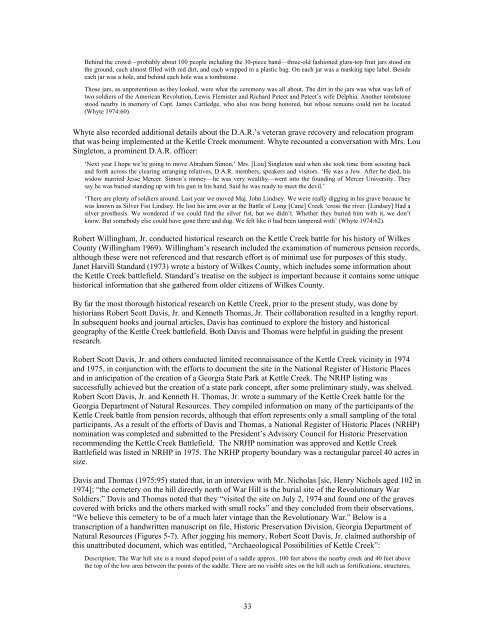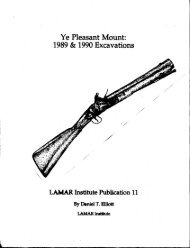Stirring Up a Hornet's Nest: - UGA Laboratory of Archaeology ...
Stirring Up a Hornet's Nest: - UGA Laboratory of Archaeology ...
Stirring Up a Hornet's Nest: - UGA Laboratory of Archaeology ...
You also want an ePaper? Increase the reach of your titles
YUMPU automatically turns print PDFs into web optimized ePapers that Google loves.
Behind the crowd—probably about 100 people including the 30-piece band—three-old fashioned glass-top fruit jars stood on<br />
the ground, each almost filled with red dirt, and each wrapped in a plastic bag. On each jar was a masking tape label. Beside<br />
each jar was a hole, and behind each hole was a tombstone.<br />
Those jars, as unpretentious as they looked, were what the ceremony was all about. The dirt in the jars was what was left <strong>of</strong><br />
two soldiers <strong>of</strong> the American Revolution, Lewis Flemister and Richard Peteet and Peteet’s wife Delphia. Another tombstone<br />
stood nearby in memory <strong>of</strong> Capt. James Cartledge, who also was being honored, but whose remains could not be located<br />
(Whyte 1974:60).<br />
Whyte also recorded additional details about the D.A.R.’s veteran grave recovery and relocation program<br />
that was being implemented at the Kettle Creek monument. Whyte recounted a conversation with Mrs. Lou<br />
Singleton, a prominent D.A.R. <strong>of</strong>ficer:<br />
‘Next year I hope we’re going to move Abraham Simon,’ Mrs. [Lou] Singleton said when she took time from scooting back<br />
and forth across the clearing arranging relatives, D.A.R. members, speakers and visitors. ‘He was a Jew. After he died, his<br />
widow married Jesse Mercer. Simon’s money—he was very wealthy—went into the founding <strong>of</strong> Mercer University. They<br />
say he was buried standing up with his gun in his hand. Said he was ready to meet the devil.’<br />
‘There are plenty <strong>of</strong> soldiers around. Last year we moved Maj. John Lindsey. We were really digging in his grave because he<br />
was known as Silver Fist Lindsey. He lost his arm over at the Battle <strong>of</strong> Long [Cane] Creek ‘cross the river. [Lindsey] Had a<br />
silver prosthesis. We wondered if we could find the silver fist, but we didn’t. Whether they buried him with it, we don’t<br />
know. But somebody else could have gone there and dug. We felt like it had been tampered with’ (Whyte 1974:62).<br />
Robert Willingham, Jr. conducted historical research on the Kettle Creek battle for his history <strong>of</strong> Wilkes<br />
County (Willingham 1969). Willingham’s research included the examination <strong>of</strong> numerous pension records,<br />
although these were not referenced and that research effort is <strong>of</strong> minimal use for purposes <strong>of</strong> this study.<br />
Janet Harvill Standard (1973) wrote a history <strong>of</strong> Wilkes County, which includes some information about<br />
the Kettle Creek battlefield. Standard’s treatise on the subject is important because it contains some unique<br />
historical information that she gathered from older citizens <strong>of</strong> Wilkes County.<br />
By far the most thorough historical research on Kettle Creek, prior to the present study, was done by<br />
historians Robert Scott Davis, Jr. and Kenneth Thomas, Jr. Their collaboration resulted in a lengthy report.<br />
In subsequent books and journal articles, Davis has continued to explore the history and historical<br />
geography <strong>of</strong> the Kettle Creek battlefield. Both Davis and Thomas were helpful in guiding the present<br />
research.<br />
Robert Scott Davis, Jr. and others conducted limited reconnaissance <strong>of</strong> the Kettle Creek vicinity in 1974<br />
and 1975, in conjunction with the efforts to document the site in the National Register <strong>of</strong> Historic Places<br />
and in anticipation <strong>of</strong> the creation <strong>of</strong> a Georgia State Park at Kettle Creek. The NRHP listing was<br />
successfully achieved but the creation <strong>of</strong> a state park concept, after some preliminary study, was shelved.<br />
Robert Scott Davis, Jr. and Kenneth H. Thomas, Jr. wrote a summary <strong>of</strong> the Kettle Creek battle for the<br />
Georgia Department <strong>of</strong> Natural Resources. They compiled information on many <strong>of</strong> the participants <strong>of</strong> the<br />
Kettle Creek battle from pension records, although that effort represents only a small sampling <strong>of</strong> the total<br />
participants. As a result <strong>of</strong> the efforts <strong>of</strong> Davis and Thomas, a National Register <strong>of</strong> Historic Places (NRHP)<br />
nomination was completed and submitted to the President’s Advisory Council for Historic Preservation<br />
recommending the Kettle Creek Battlefield. The NRHP nomination was approved and Kettle Creek<br />
Battlefield was listed in NRHP in 1975. The NRHP property boundary was a rectangular parcel 40 acres in<br />
size.<br />
Davis and Thomas (1975:95) stated that, in an interview with Mr. Nicholas [sic, Henry Nichols aged 102 in<br />
1974]; “the cemetery on the hill directly north <strong>of</strong> War Hill is the burial site <strong>of</strong> the Revolutionary War<br />
Soldiers.” Davis and Thomas noted that they “visited the site on July 2, 1974 and found one <strong>of</strong> the graves<br />
covered with bricks and the others marked with small rocks” and they concluded from their observations,<br />
“We believe this cemetery to be <strong>of</strong> a much later vintage than the Revolutionary War.” Below is a<br />
transcription <strong>of</strong> a handwritten manuscript on file, Historic Preservation Division, Georgia Department <strong>of</strong><br />
Natural Resources (Figures 5-7). After jogging his memory, Robert Scott Davis, Jr. claimed authorship <strong>of</strong><br />
this unattributed document, which was entitled, “Archaeological Possibilities <strong>of</strong> Kettle Creek”:<br />
Description: The War hill site is a round shaped point <strong>of</strong> a saddle approx. 100 feet above the nearby creek and 40 feet above<br />
the top <strong>of</strong> the low area between the points <strong>of</strong> the saddle. There are no visible sites on the hill such as fortifications, structures,<br />
33










